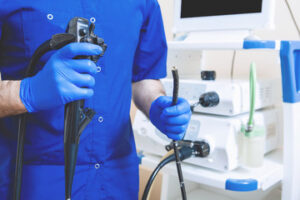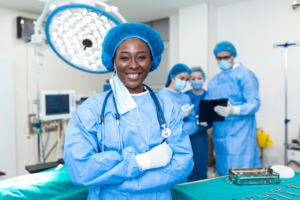Colonoscopy Phoenix is a common, safe test that helps doctors find and remove colon polyps or cancer. Your doctor may also use this test to evaluate symptoms such as rectal bleeding or a change in your bowel habits.

You will need to prepare your bowel for the procedure by eating light, clear liquids and taking strong laxatives (pills, powder you dissolve in liquid or an enema). Your doctor will provide specific instructions about how to prep.
A colonoscopy is a procedure that allows doctors to see the inside of your large bowel (colon) and rectum. A gastroenterologist will use a long, firm and flexible tube with a camera on the end, called a colonoscope. The camera displays pictures on a monitor so that the doctor can see what’s happening inside. A colonoscopy can help find and remove growths, or polyps, which could be precancerous or cancerous.
The colonoscope is inserted into the rectum and then up through the sigmoid or anus, ending in the large intestine, or colon. The colon is a long, narrow tube that stores undigested food, then sends it to the rectum for final digestion and elimination in the form of stool. Your consultant may recommend a colonoscopy if you have symptoms such as abdominal pain, diarrhea, rectal bleeding or unexplained weight loss.
Your consultant will also recommend a colonoscopy to screen for colorectal cancer. People at average risk should have a colonoscopy every 10 years. However, your consultant might suggest screenings start earlier if you have a family history of polyps or colon cancer or if you have a condition such as inflammatory bowel disease or ulcerative colitis, which increases your risk for colon cancer.
During the test, you’ll be given a sedative or anesthesia that will make you drowsy and stop you feeling any pain during the procedure. It’s important to arrange for someone to drive you home after the exam because the sedative or anesthesia will take some time to wear off.
You’ll need to drink a lot of fluids the day before your colonoscopy and on the day of it. You’ll also need to take laxatives, either in pill or liquid form, or use an enema kit the night before and morning of your procedure.
When you’re ready for your procedure, you’ll lie down on a table and the endoscopist will insert the colonoscope into the rectum. You’ll be given a painkiller and a medicine to make you drowsy through a needle in your arm or hand (intravenous, or IV) or with a breathing machine (gas and air, or Enteronox). Your consultant might need to remove any area of abnormal tissue, which will usually be done under sedation.
Preparation for a colonoscopy
The test is done by inserting a tube with a camera into the anus and then up to the colon. The camera can detect polyps and pre-cancerous growths, as well as any other abnormalities. This procedure is painless and relatively short, with patients usually able to go home within 30 to 60 minutes.
Before the procedure, your doctor will ask you to drink a special laxative liquid to empty your bowel. This is known as the bowel preparation, and it is an important step to ensure that the gastroenterologist has a clear view of your colon.
You will need to follow specific preparation instructions for your particular circumstances, but in general, you should start drinking the bowel prep the night before and finish the second round early on the morning of your procedure. You may also need to limit your diet and stop certain medications for a day or so before the test. This includes medications for diarrhea, such as Imodium or Kaopectate, and those that contain iron.
If you are worried about how much the bowel prep will hurt or if it is too difficult for you, talk to your gastroenterologist. He or she can discuss alternative bowel preps, which are typically more tolerable and result in less discomfort. The doctor can also provide you with specific instructions about modifying the preparation to suit your medical history.
Some people experience cramping or tenderness in their tummy after the test, particularly if they have had polyps or a biopsy removed. This is usually a temporary sensation that goes away on its own within a few hours. In rare cases, the bowel wall can tear after the procedure, but this is very unlikely to be life-threatening and can be repaired in the hospital.
Before the procedure, make sure you have arranged for someone to drive you to and from the hospital and take you home afterwards. You will likely be given an anaesthetic for the sedation and may need to stay overnight in hospital. You should also avoid driving, operating heavy machinery and signing legally binding documents for 24 hours after the procedure.
The procedure
A colonoscopy is done in a procedure room at your health care provider’s office or in the outpatient department of a hospital or medical center. You will be asked to change out of your street clothes and into a hospital gown. You will lie on your side, with your knees drawn up toward your chest. You will be given medicine through a vein (IV) to help you relax and sleep. You will have a heart rate and breathing monitor and may also be attached to oxygen through a mask. Because you will be given sedation or anesthesia you should arrange for someone to drive you to the test and back home afterward because you will not be able to drive while the effects of the medication are still wearing off.
A gastroenterologist, a specialist in diseases of the intestines and colon, will perform the procedure. The doctor will insert a long, thin, flexible tube with a camera on the end of it (called a colonoscope) into your anus and up into your rectum and colon. The doctor will look for abnormal tissue, such as polyps, and will remove any that are found. The doctor will also take a sample of the tissue for further examination. The doctor will also spray the lining of your colon with a special dye so that it is easier to see and can make sure all the areas are examined.
The procedure can be uncomfortable but shouldn’t cause pain. You will be given medications to help you relax and sleep through most of the procedure. Your doctor will ask you to breathe deeply and slowly while the tube is being inserted. You might also be asked to move around slightly to help the doctor get a good view of the bowel lining. You might have a feeling of fullness in your abdomen and some cramping as the tube is inserted into the colon. Once the doctor has finished, you might have a little bleeding from the tissues he or she has removed.
Most people have some discomfort after the colonoscopy, but it should go away soon. You might have some gas and bloating, especially if air or carbon dioxide are passed into the bowel during the test. You might also have a little blood in your first bowel movement after the test, but this is normal.
Post-procedure care
A colonoscopy allows doctors to look at your entire bowel. It can find polyps and cancer and also check for the extent of the disease. People who have a family history of colon cancer should start screening at age 45 and should have regular tests every five years.
You will be given medicine, usually through an IV, to make you sleepy and relaxed. Your heart rate and breathing will be monitored throughout the test.
You may feel some cramping and bloating after the procedure. This is because of the air or carbon dioxide that has been pumped into your bowel during the test. This should pass quickly. You might also have some blood in your stool after the test. This is very rare and most of the time it stops on its own.
Your doctor will probably remove a few polyps during the procedure. This is very important as most colon cancers begin as polyps. It’s also very important to get a biopsy of any tissue that looks abnormal. The results of this will help your doctor decide if any treatment is needed.
Depending on the findings of the biopsy, your doctor might remove more polyps or some other treatment will be recommended. Your doctor can tell you if the tissue is cancerous or not, and the stage of the tumor (how far it has spread).
After the procedure you will be put in a recovery room until the effects of the sedation and pain medicine wear off. You need to arrange for someone to drive you home as it is not safe to drive after this type of medication. It can take a few hours before you have a bowel movement again, as the sedatives and pain medications slow your stomach’s work. You will need to drink plenty of fluids after the test. You might experience abdominal bloating and cramping, but this should pass with the passage of gas. Generally this discomfort is not severe and should disappear within a few hours. You should discuss the results of your test with your gastroenterologist and your primary care provider.
